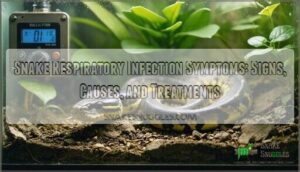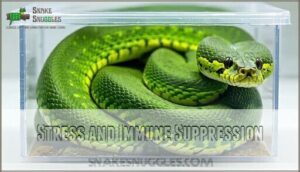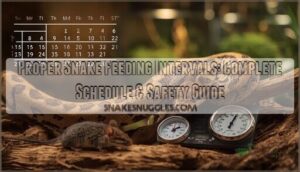This site is supported by our readers. We may earn a commission, at no cost to you, if you purchase through links.

Watch for open-mouth breathing, bubbles or discharge from the nostrils, wheezing sounds, and abnormal posturing with the head elevated.
Your snake might also show lethargy, loss of appetite, and excessive mucus in the mouth—like they’ve caught a cold, but for reptiles, it’s much more serious.
These infections often stem from improper humidity or temperature in their enclosure.
Don’t wait if you spot these signs; respiratory infections can progress rapidly in snakes.
The right environmental adjustments can make all the difference between recovery and decline.
Table Of Contents
- Key Takeaways
- Snake Respiratory Issues
- Common Symptoms
- Causes of Infections
- Treatment and Care
- Frequently Asked Questions (FAQs)
- How to know if a snake has a respiratory infection?
- How do you treat a respiratory infection in a snake?
- Should I feed my snake if it has a respiratory infection?
- How do you know if a snake has pneumonia?
- How long do symptoms of rsv last?
- What causes respiratory problems in snakes?
- How do you know if a snake is sick?
- Do snakes have respiratory disease?
- How do you know if a snake has sepsis?
- How to cure respiratory infection in snake?
- Conclusion
Key Takeaways
- You’ll notice signs like open-mouth breathing, wheezing, mucus buildup, and lethargy when your snake has a respiratory infection.
- Poor enclosure conditions, including incorrect humidity and temperature, are common causes of these infections.
- Quick treatment with veterinarian-prescribed antibiotics and proper hydration is essential for recovery.
- Maintaining a clean environment, proper husbandry, and stress reduction helps prevent respiratory infections.
Snake Respiratory Issues
When your snake has respiratory issues, you’ll notice signs like labored breathing or mucus around its mouth.
These problems often stem from bacterial, fungal, viral, or parasitic infections, which can worsen quickly without proper care, and it is crucial to address them with proper attention.
Bacterial Infections
Bacterial infections in snakes often sneak in due to opportunistic bacteria thriving in poor conditions. These infections, like bacterial pneumonia, can worsen rapidly without care.
Look out for snake respiratory infection symptoms such as mucus buildup, wheezing, or fatigue.
- Seek systemic antibiotic therapy promptly.
- Improve habitat to avoid secondary infections.
- Monitor antibiotic resistance risks diligently.
Fungal Infections
Fungal infections, like Aspergillus, can wreak havoc on a snake’s respiratory system.
Symptoms include wheezing, open-mouth breathing, and mucus buildup.
Proper fungal diagnosis helps determine treatment, often requiring antifungal drugs like itraconazole.
Here’s a breakdown:
| Symptom | Cause | Treatment |
|---|---|---|
| Wheezing | Fungus in lungs | Antifungal medications |
| Mucus build-up | Respiratory infection | Environmental control |
| Lethargy | Immune suppression | Immune support |
Preventative measures, like clean environments, minimize risks.
Viral Infections
Snake viral infections, like nidovirus and paramyxovirus, can quickly spread through viral shedding.
Snake viral infections, like nidovirus and paramyxovirus, spread rapidly through viral shedding, emphasizing the urgent need for prevention and care.
Symptoms include wheezing, open-mouth breathing, and fatigue. These infections risk immunity development and worsen respiratory symptoms if untreated.
Prioritize prevention strategies, like quarantining new snakes, to protect your slithering friend. Without proper care, snake respiratory infections caused by viral agents could become severe, leaving healthy breathing out of reach.
Parasitic Infections
Parasitic infections, like lungworm infections or pentastome infections, can wreak havoc on your snake’s respiratory system.
Mite infestations or protozoan parasites compromise immunity, making recovery tougher.
Symptoms include nasal discharge, wheezing, and difficulty breathing.
Treating parasites involves antiparasitic drugs and improved hygiene.
A key step involves identifying specific pathogens for accurate treatment.
Always inspect food, keep enclosures spotless, and monitor for sneaky signs of snake parasitic infections to prevent complications, ensuring a clean environment is crucial for preventing respiratory system issues and maintaining overall snake health with proper hygiene.
Common Symptoms
When your snake isn’t feeling its best, subtle signs like wheezing or lethargy might be the first clue.
Recognizing common symptoms early, such as open-mouth breathing or nasal discharge, can help you act quickly to prevent the condition from worsening, which is a complete concept in snake care.
Increased Respiratory Rate
Noticing an increased respiratory rate in your snake can indicate stress, illness, or snake respiratory disease like an infection.
Normal snake respiration is smooth and steady, but tachypnea (fast breathing) suggests trouble.
Watch for these snake RI symptoms:
- Quick, visible rib movements
- Audible breaths or small wheezes
- Mouth slightly agape while breathing
- Extra effort in gular pumping
Open-Mouth Breathing
Open-mouth breathing in snakes often signals respiratory distress and airway obstruction.
You might notice your snake propping its head up, struggling to draw air. This behavior usually points to advanced snake respiratory disease and could lead to secondary infections if ignored.
Warning signs of respiratory issues like these shouldn’t be ignored. Keep an eye on prognosis factors and seek emergency intervention quickly, as untreated snake mouth breathing can escalate to life-threatening conditions.
Discharge From Nares
Nasal discharge in snakes, whether clear, thick, or discolored, is a typical sign of respiratory infections.
Pay attention to the discharge consistency, color, and volume, as well as associated symptoms like labored breathing.
Unilateral discharge might indicate localized issues.
Prompt attention prevents complications.
- Common Signs:
- Clear or thick mucus
- Yellow, green, or red discharge
- Unilateral nasal blockage
- Increased discharge volume
- Labored breathing
Lethargy and Loss of Appetite
A sluggish snake showing reduced activity and feeding problems might be battling lethargy or decreased appetite.
Appetite loss, or anorexia, causes weight decline and overall weakness.
These weakness signs often accompany respiratory infections.
Snakes rely on regular meals to maintain strength, so if your pet seems uninterested in food, it’s imperative to address the issue swiftly with a veterinarian’s help to prevent further weakness.
Wheezing or Gurgling Sounds
If your snake has respiratory infection symptoms, listen for wheezing or gurgling sounds when it breathes.
These noises often hint at airway obstruction caused by mucus viscosity or fluid buildup in the lungs.
Lung auscultation by a vet helps assess severity.
Differentiate these sounds early—snake wheezing can signal mild distress, while gurgling may indicate advanced infection demanding immediate care.
Causes of Infections
Infections in snakes often stem from poor living conditions, inadequate care, or exposure to sick reptiles.
Stress and weakened immune systems can make them more vulnerable to harmful bacteria, viruses, or other pathogens.
Poor Environmental Conditions
When environmental conditions are off, problems start fast.
Without proper thermal gradients or humidity control, your snake’s immune system can weaken, inviting respiratory troubles.
Poor ventilation and dirty enclosures trap pathogens, turning the reptile environment into a health hazard.
Proper airflow requires adequate snake enclosure ventilation.
Even substrate choice matters—holding moisture or dust can affect breathing.
Keep their world clean, balanced, and breathable to avoid issues.
Inadequate Husbandry
Poor husbandry invites trouble, increasing the risk of snake respiratory infection symptoms. Neglecting basics like thermal gradients or humidity control weakens your snake’s immune defense.
- Cleanliness matters: Dirty enclosures harbor harmful pathogens.
- Proper feeding guarantees your snake stays strong and resilient.
- Temperature regulation keeps your snake comfortable and stress-free.
Consistent cleaning with a suitable enclosure cleaner helps maintain hygiene. Focus on consistent care to keep issues at bay.
Stress and Immune Suppression
Stress undermines the snake immune system, leaving it vulnerable to infections.
Overhandling or improper enclosure size creates discomfort, while social stressors like sharing space with other reptiles heighten anxiety.
Shedding stress or poor nutrition further weakens them, leading to immune suppression.
One key element is to provide multiple hiding spots to reduce stress.
Reducing stressors in their environment is key to preventing snake respiratory infection symptoms and boosting overall health and resilience.
Contagion From Other Reptiles
While immune-suppressed reptiles are vulnerable, your collection faces another threat: contagion from infected reptiles.
Many respiratory pathogens spread easily between snakes and other reptiles sharing airspace or equipment.
To prevent transmission of snake respiratory infection symptoms:
- Implement strict quarantine protocols for new arrivals (30-45 days minimum)
- Never share water dishes, hides, or handling tools between enclosures
- Wash hands thoroughly between handling different reptiles
Carrier reptiles may show no symptoms while harboring bacterial infections that devastate your collection.
Treatment and Care
You’ll need to act quickly if your snake shows signs of respiratory infection, consulting a reptile veterinarian for proper antibiotic treatment and care instructions.
Your immediate focus should be on correcting environmental factors like temperature and humidity while providing supportive care that includes proper hydration and potentially nebulization therapy to help your scaly friend breathe easier.
Antibiotic Therapy
When your snake shows respiratory infection symptoms, antibiotic therapy becomes the cornerstone of treatment.
Veterinarians typically prescribe enrofloxacin or ceftazidime, administered through injection for better absorption. Injectable antibiotics are preferred over oral methods due to easier administration.
Treatment should begin after collecting diagnostic samples and evaluating your snake’s response to environmental adjustments.
Nebulization therapy using antibiotics diluted in saline can complement parenteral treatment, especially for severe bacterial infections. Respiratory issues can sometimes be linked to underlying health problems, which may require antibiotic therapy and parenteral treatment to address the underlying health problems.
Supportive Care and Hydration
While your snake battles a respiratory infection, supportive care becomes just as vital as medication for recovery.
Proper hydration forms the cornerstone of effective reptile treatment.
To support your snake’s healing process:
- Certify fluid therapy through veterinarian-administered subcutaneous fluids
- Offer shallow water dishes for voluntary drinking
- Maintain appropriate humidity levels without creating excessive moisture
Monitor for appetite stimulation and consider nutritional support if your snake refuses food during recovery.
Environmental Modifications
While supportive care keeps your snake stable, proper environmental modifications are equally important for recovery.
Create appropriate thermal gradients (85-90°F warm side, 75-80°F cool side) to boost your snake’s immune function.
Maintain species-specific humidity control using hygrometers to monitor levels.
Choose clean substrates that won’t harbor bacteria, and guarantee adequate ventilation needs are met without drafts.
Proper enclosure size prevents stress, giving your snake space to thermoregulate effectively during healing, ensuring a stable environment for recovery with adequate ventilation.
Monitoring and Follow-up Care
With your snake on the mend, regular monitoring becomes your next focus.
Track their weight weekly and watch for behavior changes that might signal a relapse. Stick to the full course of medications—even if symptoms improve.
Your vet will schedule follow-up visits to guarantee full recovery and prevent recurrence.
Maintaining proper husbandry adjustments is your best defense for long-term survival against respiratory infections. Remember, consistent reptile health management is worth every bit of effort, and it requires regular monitoring.
Frequently Asked Questions (FAQs)
How to know if a snake has a respiratory infection?
Look for open-mouth breathing, wheezing, bubbles around the mouth, excess mucus, and a raised head position. You’ll also notice decreased appetite, lethargy, and possibly stuck tines on their forked tongue.
How do you treat a respiratory infection in a snake?
Like battling a storm in a glass house, you’ll need veterinary care immediately.
Take your snake to an exotic vet who’ll prescribe antibiotics, possibly nebulization therapy, and recommend habitat improvements with proper temperature and humidity levels.
Should I feed my snake if it has a respiratory infection?
During a respiratory infection, don’t force-feed your snake.
Offer small prey items if it shows interest, but it’s normal for appetite to decrease.
Focus on treatment and proper environmental conditions for recovery.
How do you know if a snake has pneumonia?
You’ll recognize pneumonia in your snake by observing open-mouth breathing, bubbles around the mouth, audible wheezing, and raised head positioning.
Lethargy, weight loss, and mucus discharge are also common warning signs.
How long do symptoms of rsv last?
Patience is a virtue when battling RSV.
You’ll typically experience symptoms for 1-2 weeks, though your cough might linger longer.
Most adults recover fully within this timeframe, but complications may extend your illness, and patience is essential in these cases.
What causes respiratory problems in snakes?
Your snake’s respiratory problems are typically caused by poor husbandry conditions like incorrect temperature or humidity, bacterial infections, fungal pathogens, or stress.
Environmental factors such as dusty bedding can also contribute to breathing difficulties, which are often a result of poor husbandry conditions.
How do you know if a snake is sick?
You’ll notice your snake acts differently—like losing appetite, wheezing, or breathing with its mouth open.
Watch for mucus around the mouth or odd movements, like raising its head to breathe.
These signs need attention!
Do snakes have respiratory disease?
Like a dragon’s breath turned raspy, yes, your snake can contract respiratory diseases.
They’ll struggle with breathing, show mucus around their mouth, and may breathe with mouth open—requiring immediate veterinary attention.
How do you know if a snake has sepsis?
Signs of sepsis in a snake include lethargy, refusal to eat, discolored scales, swollen areas, abnormal discharge from mouth or cloaca, rapid breathing, and unresponsiveness to stimuli.
You’ll need immediate veterinary attention for these severe symptoms.
How to cure respiratory infection in snake?
Take your snake to a reptile vet immediately for antibiotics.
Maintain proper temperature and humidity, provide extra hydration, and make certain the enclosure’s clean.
You’ll need professional help—this isn’t a DIY situation.
Conclusion
Recognizing snake respiratory infection symptoms early is your best defense against serious complications.
By maintaining proper humidity, temperature, and hygiene in your pet’s enclosure, you’ll prevent most respiratory issues before they start.
When your scaly friend does show concerning signs, don’t hesitate to consult a reptile veterinarian.
With prompt attention and appropriate treatment, your snake can make a full recovery and return to its curious, active self, allowing for a complete and full recovery.

















